BUSM4589 - Strategic HRM's Impact on Change: A Bank A Case Study
VerifiedAdded on 2022/12/18
|10
|2564
|88
Case Study
AI Summary
This case study analyzes the role of Human Resource Management (HRM) in strategic organizational change within Bank A, a public sector banking institution in Malaysia. It examines the importance of HRM in the context of a changing work environment, emphasizing its functions in recruitment, management, and employee development. The study explores how HRM can align people management with business strategies, highlighting the importance of proactive HR leadership, understanding business performance, and addressing operational and strategic concerns. Furthermore, it delves into the impact of technology, particularly artificial intelligence, on the banking sector and the challenges faced by HR in managing this technological integration, including workforce training and data scientist shortages. The case study concludes by addressing concerns about the professional practice of HRM, emphasizing the need for strategic focus, business acumen, and proactive involvement in organizational decision-making.
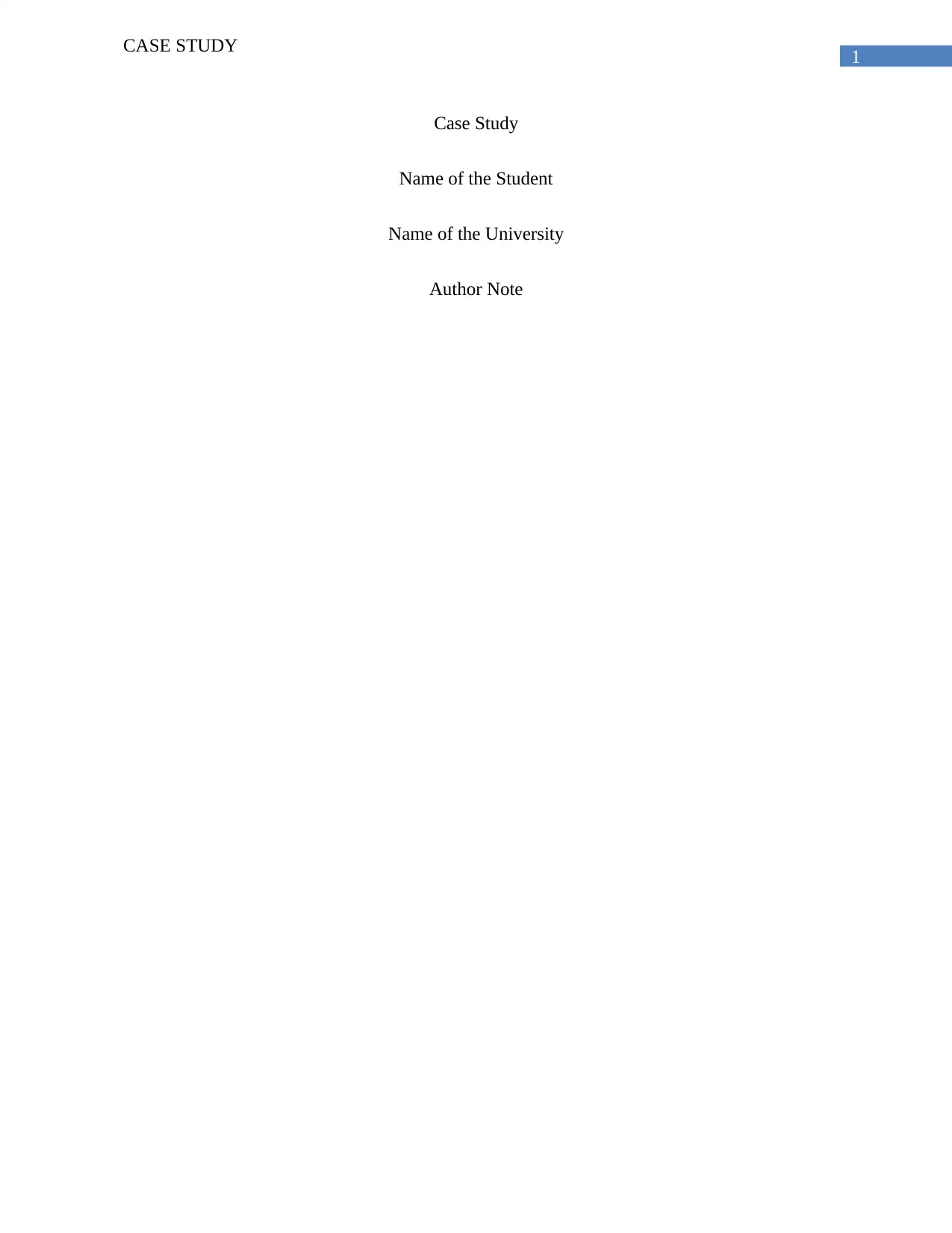
1
CASE STUDY
Case Study
Name of the Student
Name of the University
Author Note
CASE STUDY
Case Study
Name of the Student
Name of the University
Author Note
Paraphrase This Document
Need a fresh take? Get an instant paraphrase of this document with our AI Paraphraser
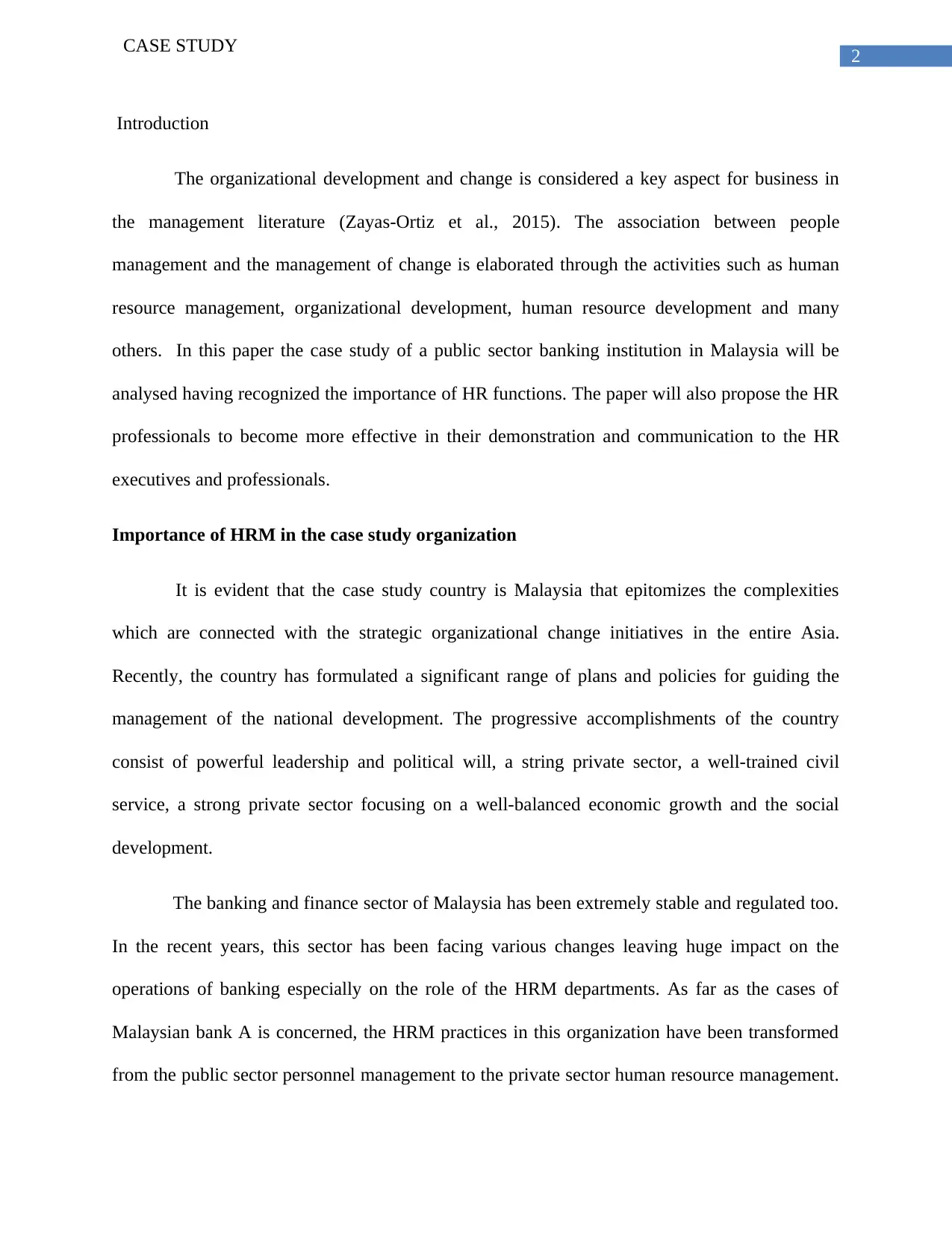
2
CASE STUDY
Introduction
The organizational development and change is considered a key aspect for business in
the management literature (Zayas-Ortiz et al., 2015). The association between people
management and the management of change is elaborated through the activities such as human
resource management, organizational development, human resource development and many
others. In this paper the case study of a public sector banking institution in Malaysia will be
analysed having recognized the importance of HR functions. The paper will also propose the HR
professionals to become more effective in their demonstration and communication to the HR
executives and professionals.
Importance of HRM in the case study organization
It is evident that the case study country is Malaysia that epitomizes the complexities
which are connected with the strategic organizational change initiatives in the entire Asia.
Recently, the country has formulated a significant range of plans and policies for guiding the
management of the national development. The progressive accomplishments of the country
consist of powerful leadership and political will, a string private sector, a well-trained civil
service, a strong private sector focusing on a well-balanced economic growth and the social
development.
The banking and finance sector of Malaysia has been extremely stable and regulated too.
In the recent years, this sector has been facing various changes leaving huge impact on the
operations of banking especially on the role of the HRM departments. As far as the cases of
Malaysian bank A is concerned, the HRM practices in this organization have been transformed
from the public sector personnel management to the private sector human resource management.
CASE STUDY
Introduction
The organizational development and change is considered a key aspect for business in
the management literature (Zayas-Ortiz et al., 2015). The association between people
management and the management of change is elaborated through the activities such as human
resource management, organizational development, human resource development and many
others. In this paper the case study of a public sector banking institution in Malaysia will be
analysed having recognized the importance of HR functions. The paper will also propose the HR
professionals to become more effective in their demonstration and communication to the HR
executives and professionals.
Importance of HRM in the case study organization
It is evident that the case study country is Malaysia that epitomizes the complexities
which are connected with the strategic organizational change initiatives in the entire Asia.
Recently, the country has formulated a significant range of plans and policies for guiding the
management of the national development. The progressive accomplishments of the country
consist of powerful leadership and political will, a string private sector, a well-trained civil
service, a strong private sector focusing on a well-balanced economic growth and the social
development.
The banking and finance sector of Malaysia has been extremely stable and regulated too.
In the recent years, this sector has been facing various changes leaving huge impact on the
operations of banking especially on the role of the HRM departments. As far as the cases of
Malaysian bank A is concerned, the HRM practices in this organization have been transformed
from the public sector personnel management to the private sector human resource management.
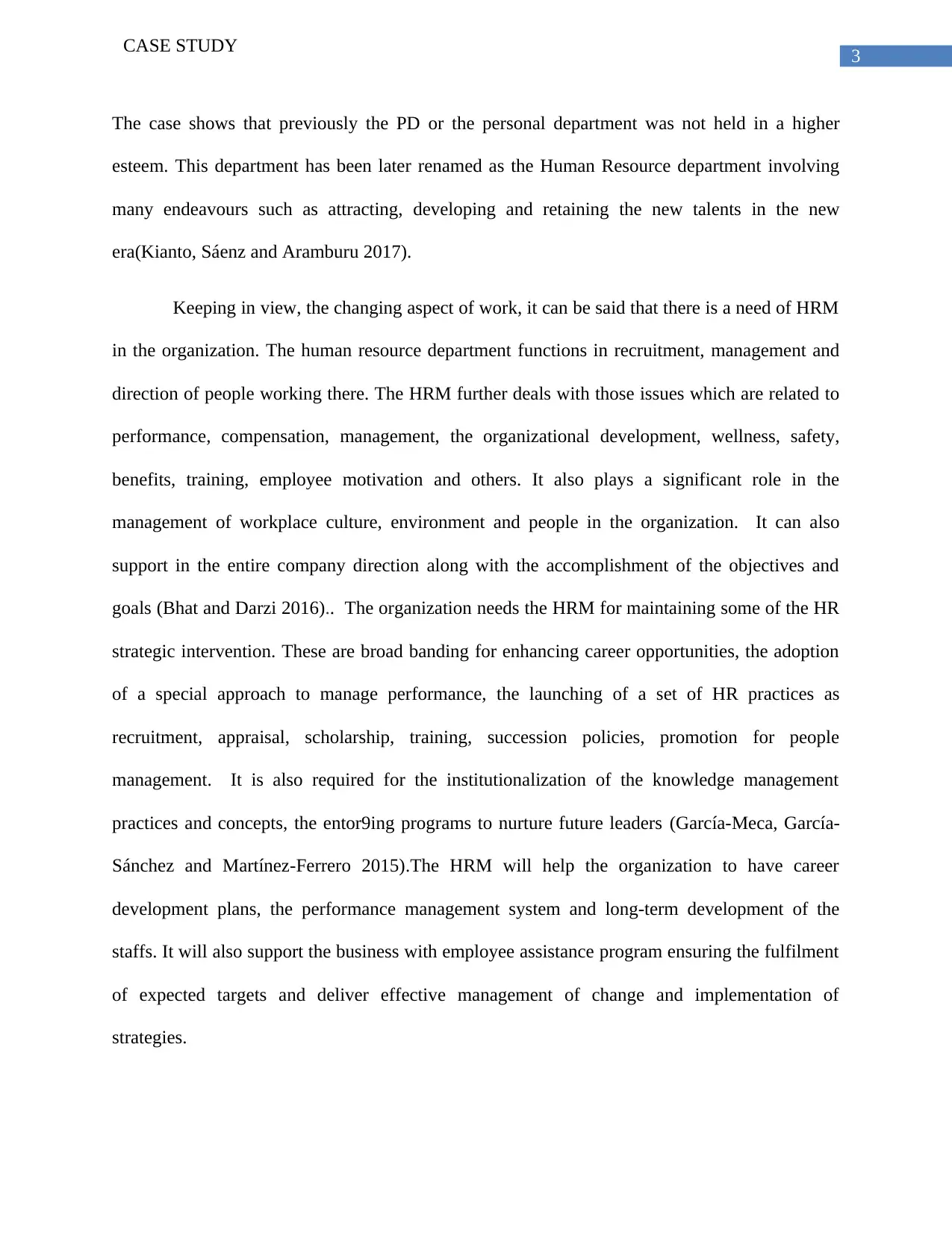
3
CASE STUDY
The case shows that previously the PD or the personal department was not held in a higher
esteem. This department has been later renamed as the Human Resource department involving
many endeavours such as attracting, developing and retaining the new talents in the new
era(Kianto, Sáenz and Aramburu 2017).
Keeping in view, the changing aspect of work, it can be said that there is a need of HRM
in the organization. The human resource department functions in recruitment, management and
direction of people working there. The HRM further deals with those issues which are related to
performance, compensation, management, the organizational development, wellness, safety,
benefits, training, employee motivation and others. It also plays a significant role in the
management of workplace culture, environment and people in the organization. It can also
support in the entire company direction along with the accomplishment of the objectives and
goals (Bhat and Darzi 2016).. The organization needs the HRM for maintaining some of the HR
strategic intervention. These are broad banding for enhancing career opportunities, the adoption
of a special approach to manage performance, the launching of a set of HR practices as
recruitment, appraisal, scholarship, training, succession policies, promotion for people
management. It is also required for the institutionalization of the knowledge management
practices and concepts, the entor9ing programs to nurture future leaders (García-Meca, García-
Sánchez and Martínez-Ferrero 2015).The HRM will help the organization to have career
development plans, the performance management system and long-term development of the
staffs. It will also support the business with employee assistance program ensuring the fulfilment
of expected targets and deliver effective management of change and implementation of
strategies.
CASE STUDY
The case shows that previously the PD or the personal department was not held in a higher
esteem. This department has been later renamed as the Human Resource department involving
many endeavours such as attracting, developing and retaining the new talents in the new
era(Kianto, Sáenz and Aramburu 2017).
Keeping in view, the changing aspect of work, it can be said that there is a need of HRM
in the organization. The human resource department functions in recruitment, management and
direction of people working there. The HRM further deals with those issues which are related to
performance, compensation, management, the organizational development, wellness, safety,
benefits, training, employee motivation and others. It also plays a significant role in the
management of workplace culture, environment and people in the organization. It can also
support in the entire company direction along with the accomplishment of the objectives and
goals (Bhat and Darzi 2016).. The organization needs the HRM for maintaining some of the HR
strategic intervention. These are broad banding for enhancing career opportunities, the adoption
of a special approach to manage performance, the launching of a set of HR practices as
recruitment, appraisal, scholarship, training, succession policies, promotion for people
management. It is also required for the institutionalization of the knowledge management
practices and concepts, the entor9ing programs to nurture future leaders (García-Meca, García-
Sánchez and Martínez-Ferrero 2015).The HRM will help the organization to have career
development plans, the performance management system and long-term development of the
staffs. It will also support the business with employee assistance program ensuring the fulfilment
of expected targets and deliver effective management of change and implementation of
strategies.
⊘ This is a preview!⊘
Do you want full access?
Subscribe today to unlock all pages.

Trusted by 1+ million students worldwide
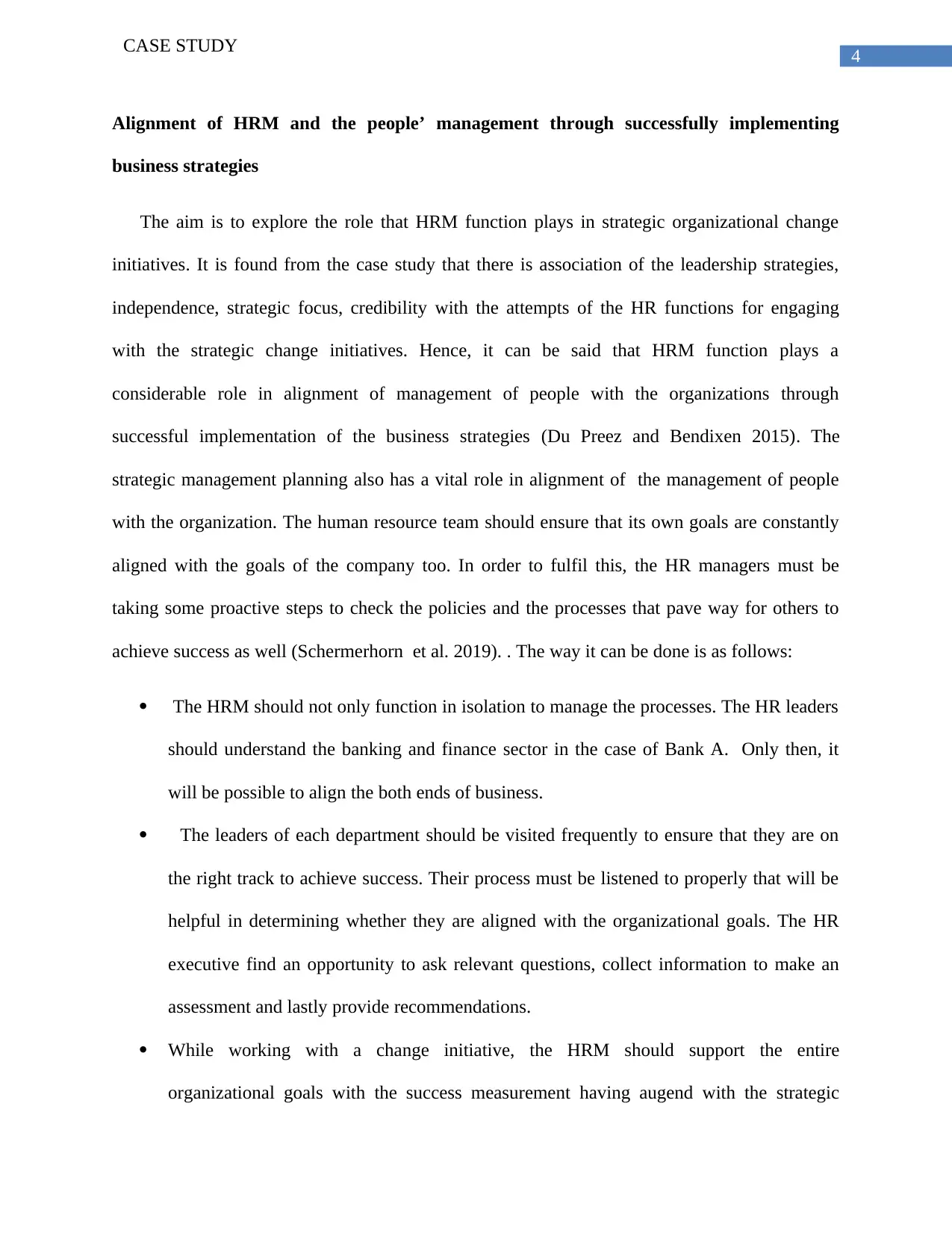
4
CASE STUDY
Alignment of HRM and the people’ management through successfully implementing
business strategies
The aim is to explore the role that HRM function plays in strategic organizational change
initiatives. It is found from the case study that there is association of the leadership strategies,
independence, strategic focus, credibility with the attempts of the HR functions for engaging
with the strategic change initiatives. Hence, it can be said that HRM function plays a
considerable role in alignment of management of people with the organizations through
successful implementation of the business strategies (Du Preez and Bendixen 2015). The
strategic management planning also has a vital role in alignment of the management of people
with the organization. The human resource team should ensure that its own goals are constantly
aligned with the goals of the company too. In order to fulfil this, the HR managers must be
taking some proactive steps to check the policies and the processes that pave way for others to
achieve success as well (Schermerhorn et al. 2019). . The way it can be done is as follows:
The HRM should not only function in isolation to manage the processes. The HR leaders
should understand the banking and finance sector in the case of Bank A. Only then, it
will be possible to align the both ends of business.
The leaders of each department should be visited frequently to ensure that they are on
the right track to achieve success. Their process must be listened to properly that will be
helpful in determining whether they are aligned with the organizational goals. The HR
executive find an opportunity to ask relevant questions, collect information to make an
assessment and lastly provide recommendations.
While working with a change initiative, the HRM should support the entire
organizational goals with the success measurement having augend with the strategic
CASE STUDY
Alignment of HRM and the people’ management through successfully implementing
business strategies
The aim is to explore the role that HRM function plays in strategic organizational change
initiatives. It is found from the case study that there is association of the leadership strategies,
independence, strategic focus, credibility with the attempts of the HR functions for engaging
with the strategic change initiatives. Hence, it can be said that HRM function plays a
considerable role in alignment of management of people with the organizations through
successful implementation of the business strategies (Du Preez and Bendixen 2015). The
strategic management planning also has a vital role in alignment of the management of people
with the organization. The human resource team should ensure that its own goals are constantly
aligned with the goals of the company too. In order to fulfil this, the HR managers must be
taking some proactive steps to check the policies and the processes that pave way for others to
achieve success as well (Schermerhorn et al. 2019). . The way it can be done is as follows:
The HRM should not only function in isolation to manage the processes. The HR leaders
should understand the banking and finance sector in the case of Bank A. Only then, it
will be possible to align the both ends of business.
The leaders of each department should be visited frequently to ensure that they are on
the right track to achieve success. Their process must be listened to properly that will be
helpful in determining whether they are aligned with the organizational goals. The HR
executive find an opportunity to ask relevant questions, collect information to make an
assessment and lastly provide recommendations.
While working with a change initiative, the HRM should support the entire
organizational goals with the success measurement having augend with the strategic
Paraphrase This Document
Need a fresh take? Get an instant paraphrase of this document with our AI Paraphraser
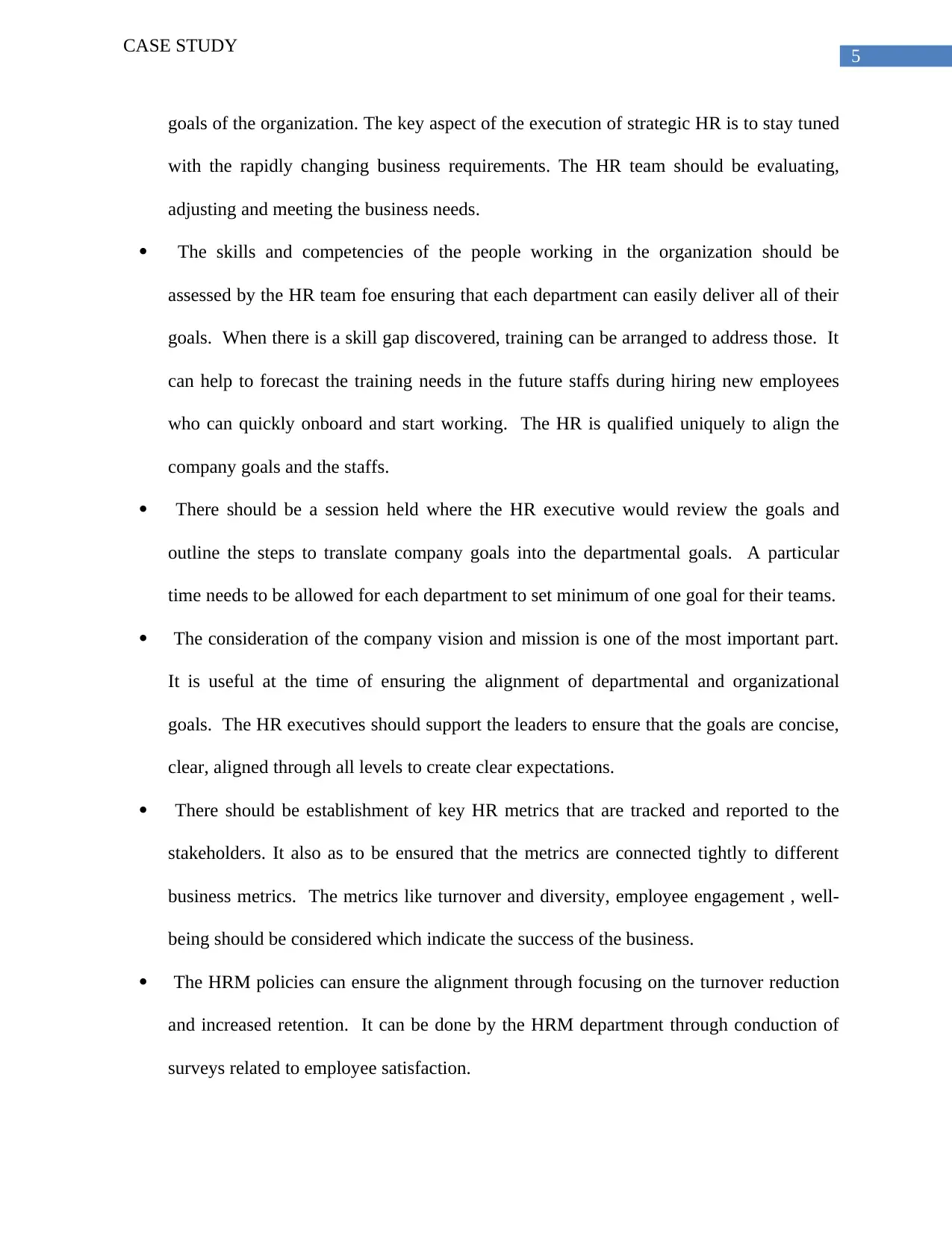
5
CASE STUDY
goals of the organization. The key aspect of the execution of strategic HR is to stay tuned
with the rapidly changing business requirements. The HR team should be evaluating,
adjusting and meeting the business needs.
The skills and competencies of the people working in the organization should be
assessed by the HR team foe ensuring that each department can easily deliver all of their
goals. When there is a skill gap discovered, training can be arranged to address those. It
can help to forecast the training needs in the future staffs during hiring new employees
who can quickly onboard and start working. The HR is qualified uniquely to align the
company goals and the staffs.
There should be a session held where the HR executive would review the goals and
outline the steps to translate company goals into the departmental goals. A particular
time needs to be allowed for each department to set minimum of one goal for their teams.
The consideration of the company vision and mission is one of the most important part.
It is useful at the time of ensuring the alignment of departmental and organizational
goals. The HR executives should support the leaders to ensure that the goals are concise,
clear, aligned through all levels to create clear expectations.
There should be establishment of key HR metrics that are tracked and reported to the
stakeholders. It also as to be ensured that the metrics are connected tightly to different
business metrics. The metrics like turnover and diversity, employee engagement , well-
being should be considered which indicate the success of the business.
The HRM policies can ensure the alignment through focusing on the turnover reduction
and increased retention. It can be done by the HRM department through conduction of
surveys related to employee satisfaction.
CASE STUDY
goals of the organization. The key aspect of the execution of strategic HR is to stay tuned
with the rapidly changing business requirements. The HR team should be evaluating,
adjusting and meeting the business needs.
The skills and competencies of the people working in the organization should be
assessed by the HR team foe ensuring that each department can easily deliver all of their
goals. When there is a skill gap discovered, training can be arranged to address those. It
can help to forecast the training needs in the future staffs during hiring new employees
who can quickly onboard and start working. The HR is qualified uniquely to align the
company goals and the staffs.
There should be a session held where the HR executive would review the goals and
outline the steps to translate company goals into the departmental goals. A particular
time needs to be allowed for each department to set minimum of one goal for their teams.
The consideration of the company vision and mission is one of the most important part.
It is useful at the time of ensuring the alignment of departmental and organizational
goals. The HR executives should support the leaders to ensure that the goals are concise,
clear, aligned through all levels to create clear expectations.
There should be establishment of key HR metrics that are tracked and reported to the
stakeholders. It also as to be ensured that the metrics are connected tightly to different
business metrics. The metrics like turnover and diversity, employee engagement , well-
being should be considered which indicate the success of the business.
The HRM policies can ensure the alignment through focusing on the turnover reduction
and increased retention. It can be done by the HRM department through conduction of
surveys related to employee satisfaction.
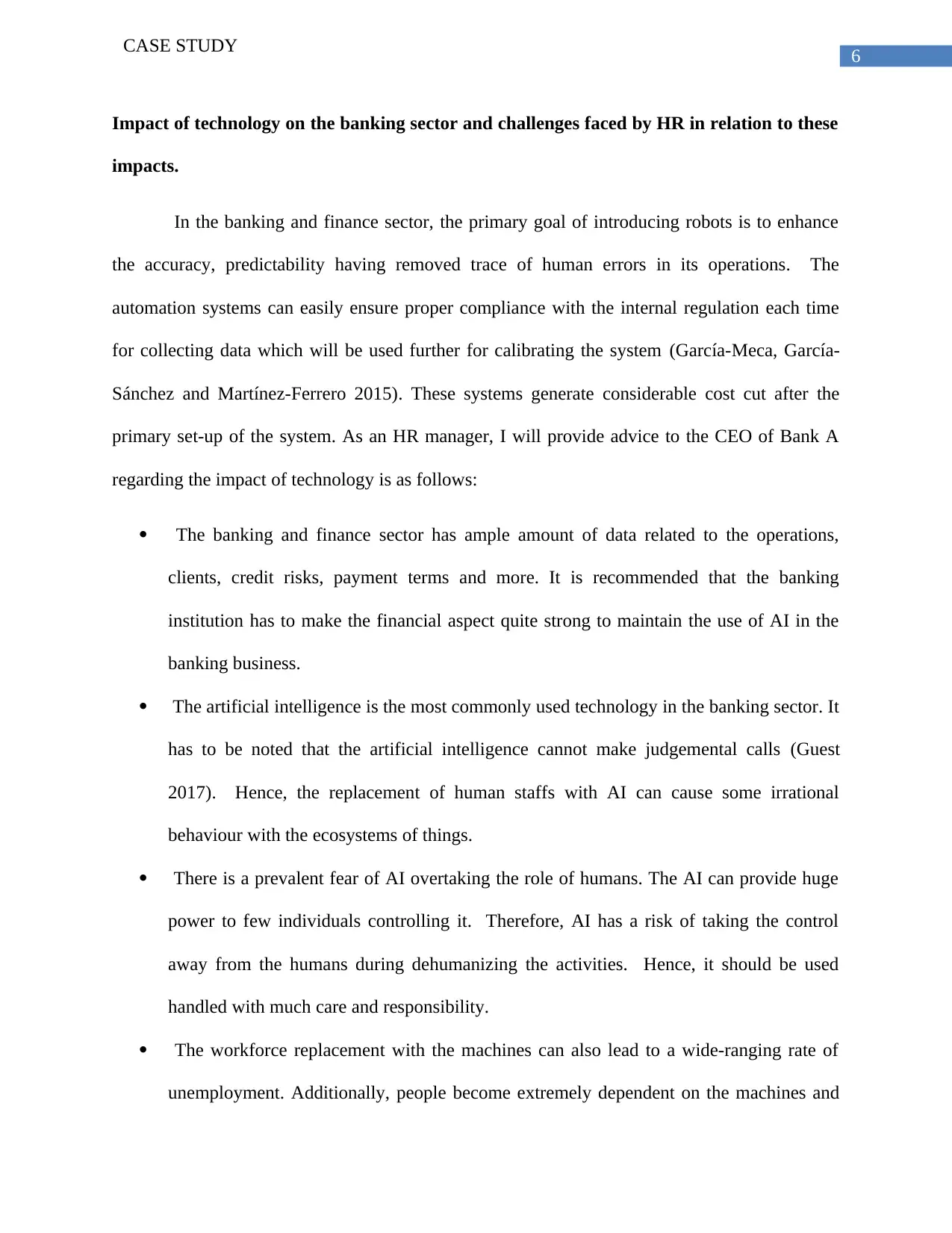
6
CASE STUDY
Impact of technology on the banking sector and challenges faced by HR in relation to these
impacts.
In the banking and finance sector, the primary goal of introducing robots is to enhance
the accuracy, predictability having removed trace of human errors in its operations. The
automation systems can easily ensure proper compliance with the internal regulation each time
for collecting data which will be used further for calibrating the system (García-Meca, García-
Sánchez and Martínez-Ferrero 2015). These systems generate considerable cost cut after the
primary set-up of the system. As an HR manager, I will provide advice to the CEO of Bank A
regarding the impact of technology is as follows:
The banking and finance sector has ample amount of data related to the operations,
clients, credit risks, payment terms and more. It is recommended that the banking
institution has to make the financial aspect quite strong to maintain the use of AI in the
banking business.
The artificial intelligence is the most commonly used technology in the banking sector. It
has to be noted that the artificial intelligence cannot make judgemental calls (Guest
2017). Hence, the replacement of human staffs with AI can cause some irrational
behaviour with the ecosystems of things.
There is a prevalent fear of AI overtaking the role of humans. The AI can provide huge
power to few individuals controlling it. Therefore, AI has a risk of taking the control
away from the humans during dehumanizing the activities. Hence, it should be used
handled with much care and responsibility.
The workforce replacement with the machines can also lead to a wide-ranging rate of
unemployment. Additionally, people become extremely dependent on the machines and
CASE STUDY
Impact of technology on the banking sector and challenges faced by HR in relation to these
impacts.
In the banking and finance sector, the primary goal of introducing robots is to enhance
the accuracy, predictability having removed trace of human errors in its operations. The
automation systems can easily ensure proper compliance with the internal regulation each time
for collecting data which will be used further for calibrating the system (García-Meca, García-
Sánchez and Martínez-Ferrero 2015). These systems generate considerable cost cut after the
primary set-up of the system. As an HR manager, I will provide advice to the CEO of Bank A
regarding the impact of technology is as follows:
The banking and finance sector has ample amount of data related to the operations,
clients, credit risks, payment terms and more. It is recommended that the banking
institution has to make the financial aspect quite strong to maintain the use of AI in the
banking business.
The artificial intelligence is the most commonly used technology in the banking sector. It
has to be noted that the artificial intelligence cannot make judgemental calls (Guest
2017). Hence, the replacement of human staffs with AI can cause some irrational
behaviour with the ecosystems of things.
There is a prevalent fear of AI overtaking the role of humans. The AI can provide huge
power to few individuals controlling it. Therefore, AI has a risk of taking the control
away from the humans during dehumanizing the activities. Hence, it should be used
handled with much care and responsibility.
The workforce replacement with the machines can also lead to a wide-ranging rate of
unemployment. Additionally, people become extremely dependent on the machines and
⊘ This is a preview!⊘
Do you want full access?
Subscribe today to unlock all pages.

Trusted by 1+ million students worldwide
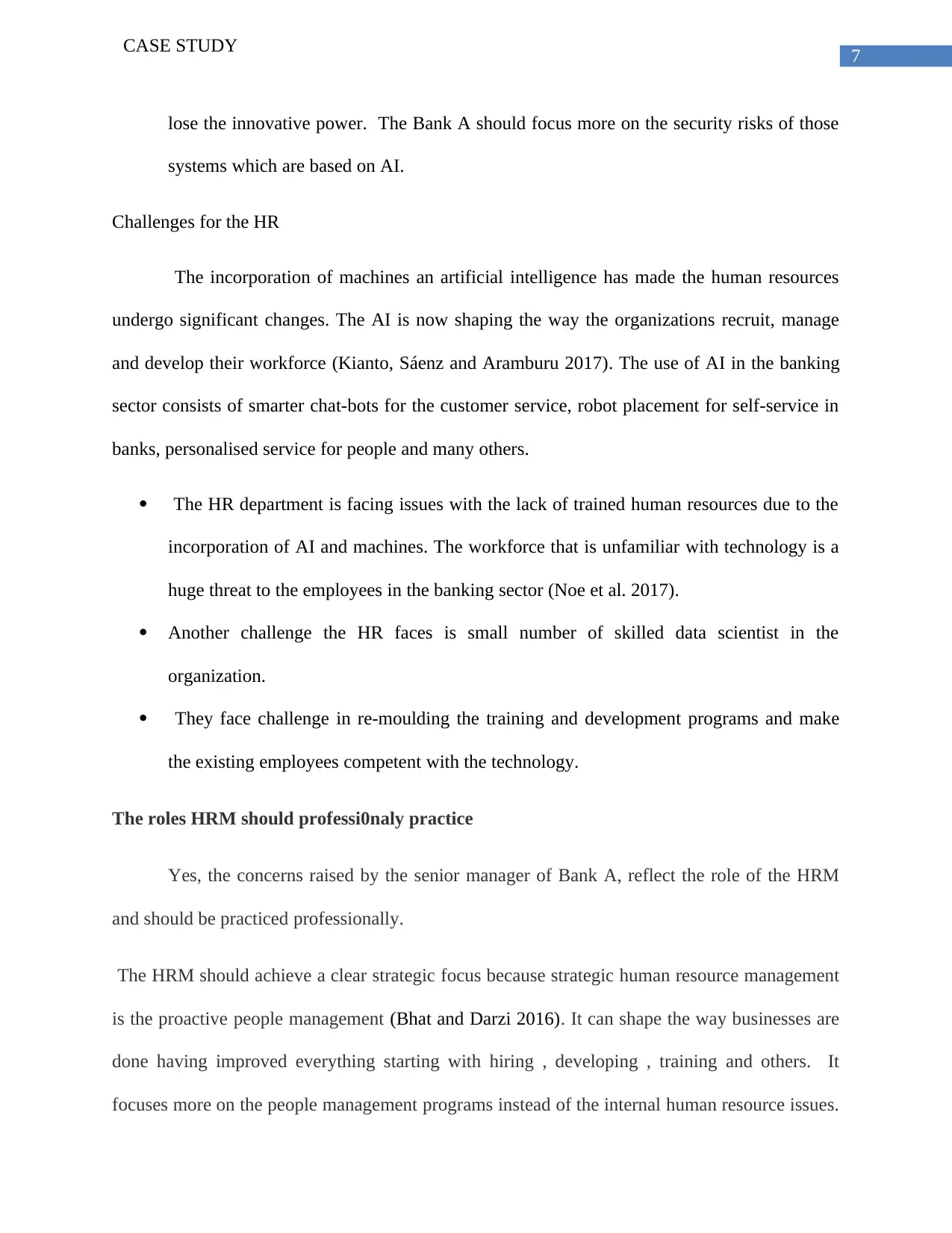
7
CASE STUDY
lose the innovative power. The Bank A should focus more on the security risks of those
systems which are based on AI.
Challenges for the HR
The incorporation of machines an artificial intelligence has made the human resources
undergo significant changes. The AI is now shaping the way the organizations recruit, manage
and develop their workforce (Kianto, Sáenz and Aramburu 2017). The use of AI in the banking
sector consists of smarter chat-bots for the customer service, robot placement for self-service in
banks, personalised service for people and many others.
The HR department is facing issues with the lack of trained human resources due to the
incorporation of AI and machines. The workforce that is unfamiliar with technology is a
huge threat to the employees in the banking sector (Noe et al. 2017).
Another challenge the HR faces is small number of skilled data scientist in the
organization.
They face challenge in re-moulding the training and development programs and make
the existing employees competent with the technology.
The roles HRM should professi0naly practice
Yes, the concerns raised by the senior manager of Bank A, reflect the role of the HRM
and should be practiced professionally.
The HRM should achieve a clear strategic focus because strategic human resource management
is the proactive people management (Bhat and Darzi 2016). It can shape the way businesses are
done having improved everything starting with hiring , developing , training and others. It
focuses more on the people management programs instead of the internal human resource issues.
CASE STUDY
lose the innovative power. The Bank A should focus more on the security risks of those
systems which are based on AI.
Challenges for the HR
The incorporation of machines an artificial intelligence has made the human resources
undergo significant changes. The AI is now shaping the way the organizations recruit, manage
and develop their workforce (Kianto, Sáenz and Aramburu 2017). The use of AI in the banking
sector consists of smarter chat-bots for the customer service, robot placement for self-service in
banks, personalised service for people and many others.
The HR department is facing issues with the lack of trained human resources due to the
incorporation of AI and machines. The workforce that is unfamiliar with technology is a
huge threat to the employees in the banking sector (Noe et al. 2017).
Another challenge the HR faces is small number of skilled data scientist in the
organization.
They face challenge in re-moulding the training and development programs and make
the existing employees competent with the technology.
The roles HRM should professi0naly practice
Yes, the concerns raised by the senior manager of Bank A, reflect the role of the HRM
and should be practiced professionally.
The HRM should achieve a clear strategic focus because strategic human resource management
is the proactive people management (Bhat and Darzi 2016). It can shape the way businesses are
done having improved everything starting with hiring , developing , training and others. It
focuses more on the people management programs instead of the internal human resource issues.
Paraphrase This Document
Need a fresh take? Get an instant paraphrase of this document with our AI Paraphraser
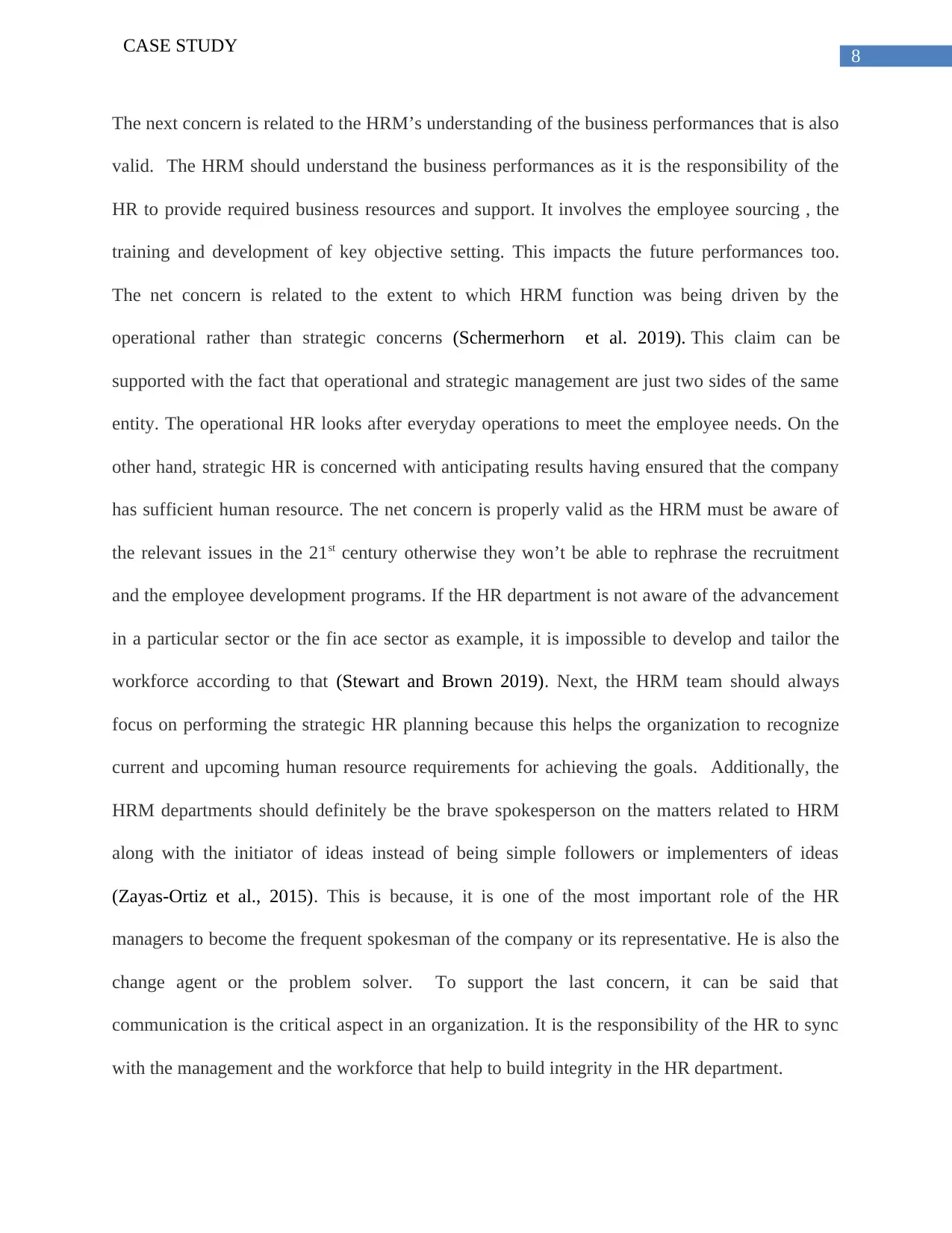
8
CASE STUDY
The next concern is related to the HRM’s understanding of the business performances that is also
valid. The HRM should understand the business performances as it is the responsibility of the
HR to provide required business resources and support. It involves the employee sourcing , the
training and development of key objective setting. This impacts the future performances too.
The net concern is related to the extent to which HRM function was being driven by the
operational rather than strategic concerns (Schermerhorn et al. 2019). This claim can be
supported with the fact that operational and strategic management are just two sides of the same
entity. The operational HR looks after everyday operations to meet the employee needs. On the
other hand, strategic HR is concerned with anticipating results having ensured that the company
has sufficient human resource. The net concern is properly valid as the HRM must be aware of
the relevant issues in the 21st century otherwise they won’t be able to rephrase the recruitment
and the employee development programs. If the HR department is not aware of the advancement
in a particular sector or the fin ace sector as example, it is impossible to develop and tailor the
workforce according to that (Stewart and Brown 2019). Next, the HRM team should always
focus on performing the strategic HR planning because this helps the organization to recognize
current and upcoming human resource requirements for achieving the goals. Additionally, the
HRM departments should definitely be the brave spokesperson on the matters related to HRM
along with the initiator of ideas instead of being simple followers or implementers of ideas
(Zayas-Ortiz et al., 2015). This is because, it is one of the most important role of the HR
managers to become the frequent spokesman of the company or its representative. He is also the
change agent or the problem solver. To support the last concern, it can be said that
communication is the critical aspect in an organization. It is the responsibility of the HR to sync
with the management and the workforce that help to build integrity in the HR department.
CASE STUDY
The next concern is related to the HRM’s understanding of the business performances that is also
valid. The HRM should understand the business performances as it is the responsibility of the
HR to provide required business resources and support. It involves the employee sourcing , the
training and development of key objective setting. This impacts the future performances too.
The net concern is related to the extent to which HRM function was being driven by the
operational rather than strategic concerns (Schermerhorn et al. 2019). This claim can be
supported with the fact that operational and strategic management are just two sides of the same
entity. The operational HR looks after everyday operations to meet the employee needs. On the
other hand, strategic HR is concerned with anticipating results having ensured that the company
has sufficient human resource. The net concern is properly valid as the HRM must be aware of
the relevant issues in the 21st century otherwise they won’t be able to rephrase the recruitment
and the employee development programs. If the HR department is not aware of the advancement
in a particular sector or the fin ace sector as example, it is impossible to develop and tailor the
workforce according to that (Stewart and Brown 2019). Next, the HRM team should always
focus on performing the strategic HR planning because this helps the organization to recognize
current and upcoming human resource requirements for achieving the goals. Additionally, the
HRM departments should definitely be the brave spokesperson on the matters related to HRM
along with the initiator of ideas instead of being simple followers or implementers of ideas
(Zayas-Ortiz et al., 2015). This is because, it is one of the most important role of the HR
managers to become the frequent spokesman of the company or its representative. He is also the
change agent or the problem solver. To support the last concern, it can be said that
communication is the critical aspect in an organization. It is the responsibility of the HR to sync
with the management and the workforce that help to build integrity in the HR department.

9
CASE STUDY
CASE STUDY
⊘ This is a preview!⊘
Do you want full access?
Subscribe today to unlock all pages.

Trusted by 1+ million students worldwide
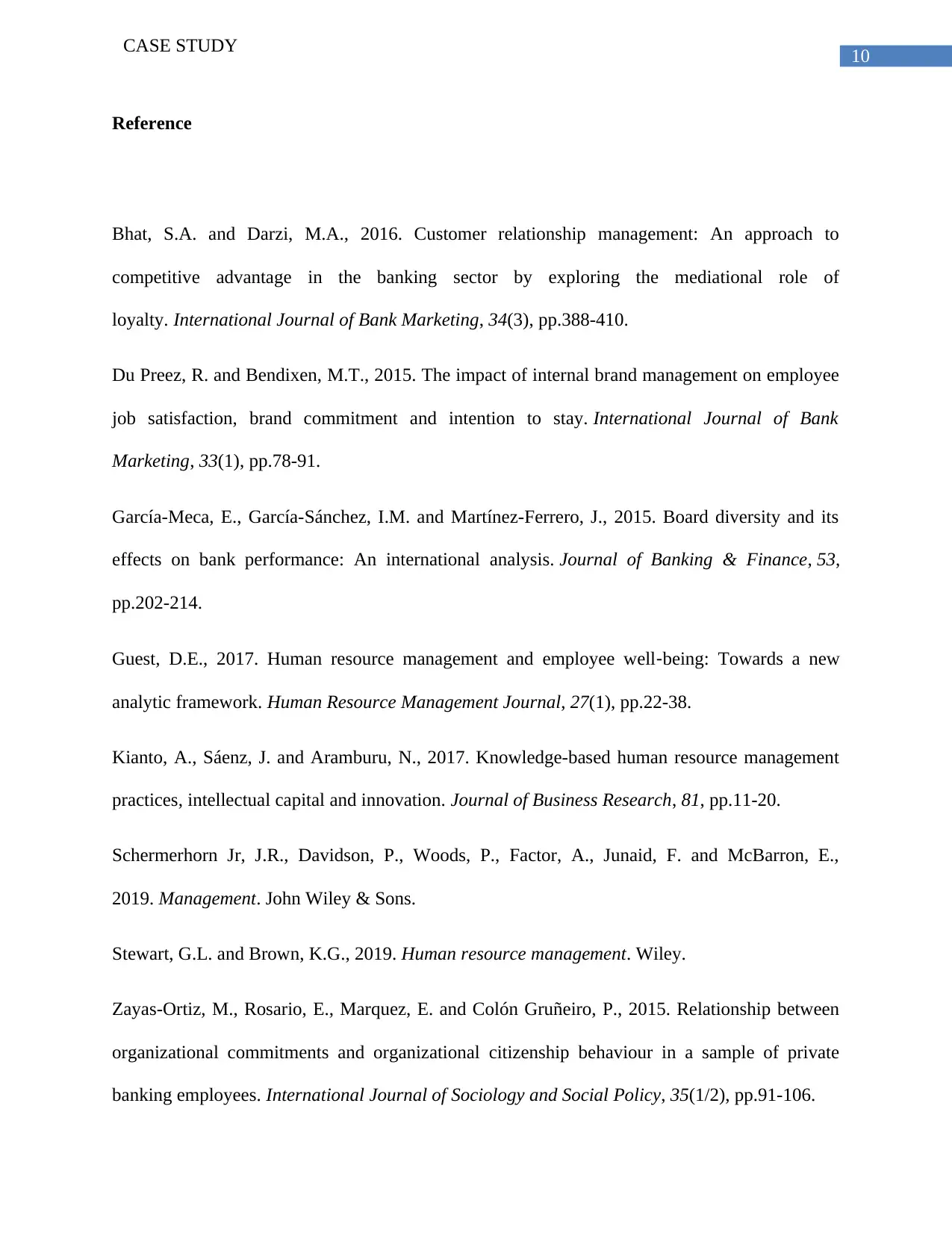
10
CASE STUDY
Reference
Bhat, S.A. and Darzi, M.A., 2016. Customer relationship management: An approach to
competitive advantage in the banking sector by exploring the mediational role of
loyalty. International Journal of Bank Marketing, 34(3), pp.388-410.
Du Preez, R. and Bendixen, M.T., 2015. The impact of internal brand management on employee
job satisfaction, brand commitment and intention to stay. International Journal of Bank
Marketing, 33(1), pp.78-91.
García-Meca, E., García-Sánchez, I.M. and Martínez-Ferrero, J., 2015. Board diversity and its
effects on bank performance: An international analysis. Journal of Banking & Finance, 53,
pp.202-214.
Guest, D.E., 2017. Human resource management and employee well‐being: Towards a new
analytic framework. Human Resource Management Journal, 27(1), pp.22-38.
Kianto, A., Sáenz, J. and Aramburu, N., 2017. Knowledge-based human resource management
practices, intellectual capital and innovation. Journal of Business Research, 81, pp.11-20.
Schermerhorn Jr, J.R., Davidson, P., Woods, P., Factor, A., Junaid, F. and McBarron, E.,
2019. Management. John Wiley & Sons.
Stewart, G.L. and Brown, K.G., 2019. Human resource management. Wiley.
Zayas-Ortiz, M., Rosario, E., Marquez, E. and Colón Gruñeiro, P., 2015. Relationship between
organizational commitments and organizational citizenship behaviour in a sample of private
banking employees. International Journal of Sociology and Social Policy, 35(1/2), pp.91-106.
CASE STUDY
Reference
Bhat, S.A. and Darzi, M.A., 2016. Customer relationship management: An approach to
competitive advantage in the banking sector by exploring the mediational role of
loyalty. International Journal of Bank Marketing, 34(3), pp.388-410.
Du Preez, R. and Bendixen, M.T., 2015. The impact of internal brand management on employee
job satisfaction, brand commitment and intention to stay. International Journal of Bank
Marketing, 33(1), pp.78-91.
García-Meca, E., García-Sánchez, I.M. and Martínez-Ferrero, J., 2015. Board diversity and its
effects on bank performance: An international analysis. Journal of Banking & Finance, 53,
pp.202-214.
Guest, D.E., 2017. Human resource management and employee well‐being: Towards a new
analytic framework. Human Resource Management Journal, 27(1), pp.22-38.
Kianto, A., Sáenz, J. and Aramburu, N., 2017. Knowledge-based human resource management
practices, intellectual capital and innovation. Journal of Business Research, 81, pp.11-20.
Schermerhorn Jr, J.R., Davidson, P., Woods, P., Factor, A., Junaid, F. and McBarron, E.,
2019. Management. John Wiley & Sons.
Stewart, G.L. and Brown, K.G., 2019. Human resource management. Wiley.
Zayas-Ortiz, M., Rosario, E., Marquez, E. and Colón Gruñeiro, P., 2015. Relationship between
organizational commitments and organizational citizenship behaviour in a sample of private
banking employees. International Journal of Sociology and Social Policy, 35(1/2), pp.91-106.
1 out of 10
Related Documents
Your All-in-One AI-Powered Toolkit for Academic Success.
+13062052269
info@desklib.com
Available 24*7 on WhatsApp / Email
![[object Object]](/_next/static/media/star-bottom.7253800d.svg)
Unlock your academic potential
Copyright © 2020–2025 A2Z Services. All Rights Reserved. Developed and managed by ZUCOL.


